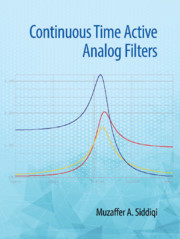Book contents
- Frontmatter
- Dedication
- Contents
- Preface
- Acknowledgments
- 1 Analog Filter: Concepts
- 2 First-and Second-order Filters
- 3 Magnitude Approximations
- 4 Delay: Approximation and Optimization
- 5 Frequency and Impedance Transformations
- 6 Sensitivity of Active Networks
- 7 Single Amplifier Second-order Filters
- 8 Multi Amplifier Second-order Filter Sections
- 9 Direct Form Synthesis: Element Substitution and Operational Simulation
- 10 Cascade Approach: Optimization and Tuning
- 11 Amplification and Filtering in Biomedical Applications
- 12 Audio Signal Processing and Anti-aliasing Filters
- 13 Follow the Leader Feedback Filters
- 14 Switched Capacitor Circuits
- 15 Operational Transconductance Amplifier-C Filters
- 16 Current Conveyors and CDTA (Current Differencing Transconductance Amplifiers) Based Filters
- 17 Active R and Active C Filters
- Index
- References
11 - Amplification and Filtering in Biomedical Applications
Published online by Cambridge University Press: 24 December 2019
- Frontmatter
- Dedication
- Contents
- Preface
- Acknowledgments
- 1 Analog Filter: Concepts
- 2 First-and Second-order Filters
- 3 Magnitude Approximations
- 4 Delay: Approximation and Optimization
- 5 Frequency and Impedance Transformations
- 6 Sensitivity of Active Networks
- 7 Single Amplifier Second-order Filters
- 8 Multi Amplifier Second-order Filter Sections
- 9 Direct Form Synthesis: Element Substitution and Operational Simulation
- 10 Cascade Approach: Optimization and Tuning
- 11 Amplification and Filtering in Biomedical Applications
- 12 Audio Signal Processing and Anti-aliasing Filters
- 13 Follow the Leader Feedback Filters
- 14 Switched Capacitor Circuits
- 15 Operational Transconductance Amplifier-C Filters
- 16 Current Conveyors and CDTA (Current Differencing Transconductance Amplifiers) Based Filters
- 17 Active R and Active C Filters
- Index
- References
Summary
Introduction
There has been a lot of development in the use of biomedical equipment for diagnostic and treatment purposes in recent times. A good amount of literature has come from the interdisciplinary area of medical engineering, medical instrumentation, and so on, making medical electronics a specialized field of study. An important constituent of electronics engineering is the study of analog filters. Hence, the design and application of analog filters finds a place in the books and literature on medical engineering and medical instrumentation too. The design of analog filters especially the continuous-time types requires special attention. However, the available books on analog filter design do not adequately relate filter design with biomedical applications. A few simple examples included in this chapter will try to bridge the gap between theoretical design and the application of analog filters in this important field.
We have already studied the basics of continuous-time analog filter in the previous chapters. In this chapter, we will first connect the design of a filter to its utilization in the field of biomedical electronics.
It is a well-known fact that cells in the human body have different element (Na+, K+, Ca++, Cl-) ion concentrations inside and outside the membrane. This difference in ion concentration creates a small electric potential called biopotential. When there is a disturbance in a biopotential, an action potential is generated which is the result of depolarization and repolarization of the cells in the human body. It is the action potential at the location (nodes) on the body which is detectable and can be processed using biomedical circuits. When such signals generated by the heart are collected, it makes up the electrocardiogram (ECG). ECG detectors use electrodes to collect these signals, which are amplified, filtered and displayed for data analysis. ECG signals require filtering and amplification to produce high-quality signals. Not only are different stages of amplification used, specific signal processing is also required. Therefore, instead of a simple (DA) differential amplifier, instrumentation amplifiers (inst-amp) are used. Section 11.2 discusses the the necessity of converting DA into an inst-amp. Transformation of the inst-amp into a biopotential amplifier and as integrated circuit inst-amps especially suitable in medical instruments and devices are discussed in Section 11.3 along with a case study on a piezoelectric transducer.
Information
- Type
- Chapter
- Information
- Continuous Time Active Analog Filters , pp. 334 - 359Publisher: Cambridge University PressPrint publication year: 2020
